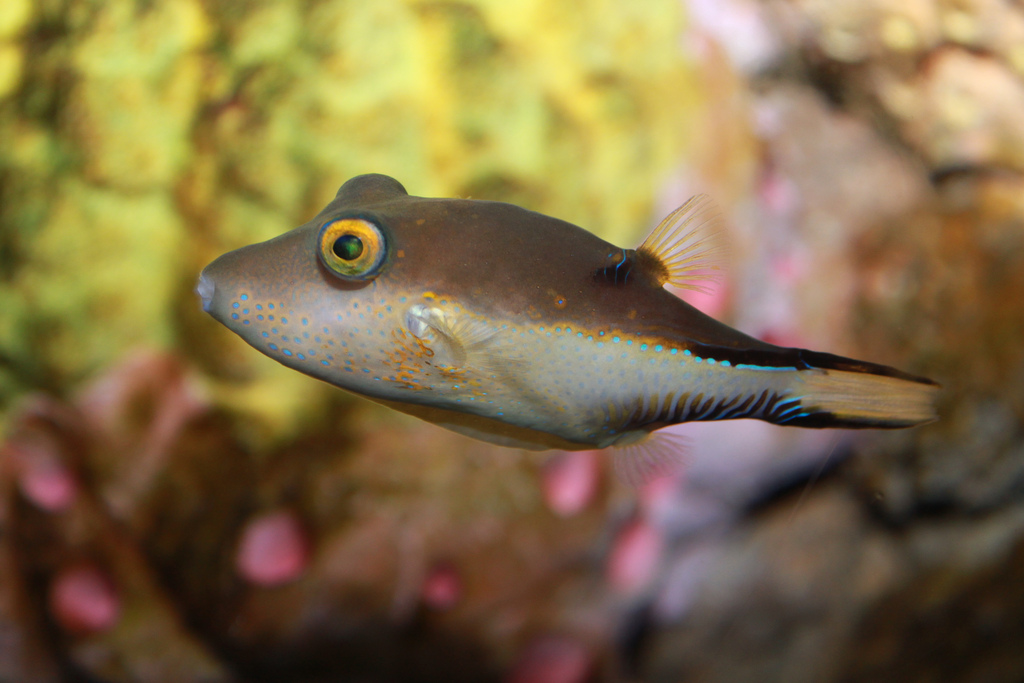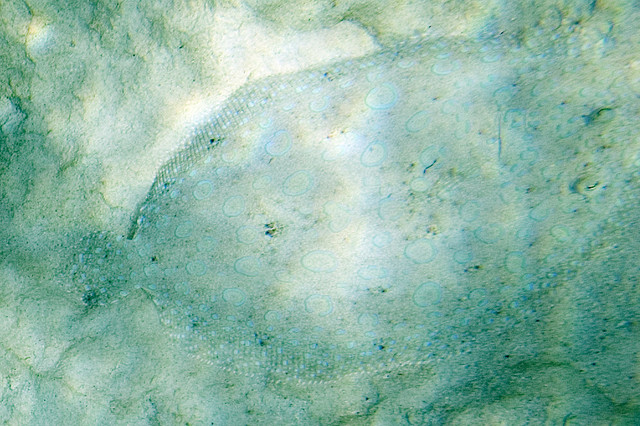Interactions
Aside from mating, the peacock flounder is a fairly
unsociable fish. Each individual will hunt alone. While females
don’t generally interact with others of their species, males
will become defensive toward other males when territory is
crossed. However, the territory occupied during the day is not
the same as the territory occupied at night. At the day’s end,
males will retire in shallower waters, whereas females will
retract into deeper habitats. (Otterbein 2011)
 The peacock flounder’s ability to change its pigmentation to
match the ocean floor is crucial to its success in hunting prey
and avoiding predators. The choice of prey for the flounder is
usually smaller fish, but has been known to consume small
crustaceans and occasionally octopi (Otterbein 2011). But
perhaps the most bizarre and seemingly unlikely choice of food
is Caribbean sharpnose puffer, or Canthigaster rostrata,
pictured to the right.
Sharpnose puffers are known for the powerful neurotoxin
tetrodotoxin that is found in their skin, mucus, and even
tissues. This fact had lead researchers to believe that pressure
from predators was fairly low, having only found the puffer in
guts of seabirds and barracuda. But the peacock flounder seems
to prove otherwise. After first locating a sharpnose puffer, the
flounder will lunge and attempt to immediately devour it.
However, the puffer fish expands, allowing most of its body to
avoid being consumed. In order to try to force the puffer to
succumb, the flounder will strike it against the ocean bottom
until it is too dazed to fight and deflates. Unlike many other
fish species that may attempt to gobble down a sharpnose puffer
fish, the peacock flounder does not regurgitate the puffer fish
or suffer any neurological response to having ingested a highly
toxic animal. (Gochfeld and Olson 2008; Otterbein 2011)
The peacock flounder’s ability to change its pigmentation to
match the ocean floor is crucial to its success in hunting prey
and avoiding predators. The choice of prey for the flounder is
usually smaller fish, but has been known to consume small
crustaceans and occasionally octopi (Otterbein 2011). But
perhaps the most bizarre and seemingly unlikely choice of food
is Caribbean sharpnose puffer, or Canthigaster rostrata,
pictured to the right.
Sharpnose puffers are known for the powerful neurotoxin
tetrodotoxin that is found in their skin, mucus, and even
tissues. This fact had lead researchers to believe that pressure
from predators was fairly low, having only found the puffer in
guts of seabirds and barracuda. But the peacock flounder seems
to prove otherwise. After first locating a sharpnose puffer, the
flounder will lunge and attempt to immediately devour it.
However, the puffer fish expands, allowing most of its body to
avoid being consumed. In order to try to force the puffer to
succumb, the flounder will strike it against the ocean bottom
until it is too dazed to fight and deflates. Unlike many other
fish species that may attempt to gobble down a sharpnose puffer
fish, the peacock flounder does not regurgitate the puffer fish
or suffer any neurological response to having ingested a highly
toxic animal. (Gochfeld and Olson 2008; Otterbein 2011)
 Being hunted by a variety of organisms, such as large fish,
rays, like the
Southern Stingray, and sharks, requires the peacock flounder to have more
than one defense mechanism. The most prominent mechanism is its
ability to change its pigmentation at a moment’s notice to match
the ocean floor. Whenever the flounder feels threatened,
however, it will also dive into the sand to attempt to avoid
detection. As you can see in the picture to the left, this
combination has camouflaged the flounder very successfully. To
see this remarkable process in action, click
here. Also, inhabiting shallower waters makes it more
difficult for larger organisms to hunt them, lowering the risk
of predation. (Otterbein 2011)
Being hunted by a variety of organisms, such as large fish,
rays, like the
Southern Stingray, and sharks, requires the peacock flounder to have more
than one defense mechanism. The most prominent mechanism is its
ability to change its pigmentation at a moment’s notice to match
the ocean floor. Whenever the flounder feels threatened,
however, it will also dive into the sand to attempt to avoid
detection. As you can see in the picture to the left, this
combination has camouflaged the flounder very successfully. To
see this remarkable process in action, click
here. Also, inhabiting shallower waters makes it more
difficult for larger organisms to hunt them, lowering the risk
of predation. (Otterbein 2011)
To continue learning about the peacock flounder, go to our page about Interesting Facts.